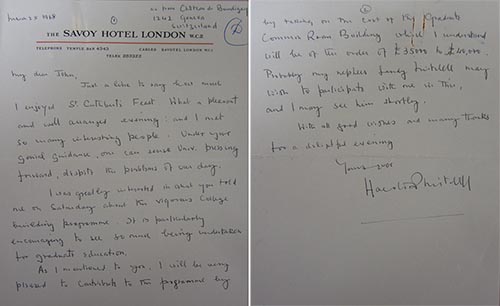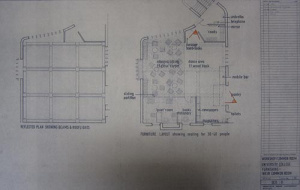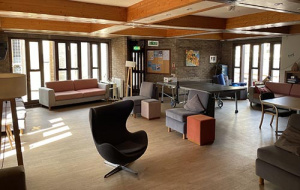A History of the Mitchell Building
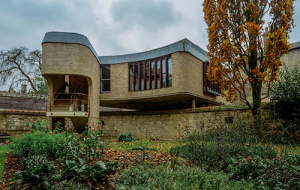 For fifty years the Mitchell Building has been an important part of the central site of the College, as being both the hub of the Works Department on the ground floor and the common room of the MCR on the first floor. It is therefore a very quirky building in having to perform two such different functions. But how did it come into being? And who, a modern audience will ask, is the “Mitchell” after whom it was named?
For fifty years the Mitchell Building has been an important part of the central site of the College, as being both the hub of the Works Department on the ground floor and the common room of the MCR on the first floor. It is therefore a very quirky building in having to perform two such different functions. But how did it come into being? And who, a modern audience will ask, is the “Mitchell” after whom it was named?
The origins of the building go back to the creation of a “Building and Development Committee” in 1965 to examine the College’s accommodation and facilities, especially for its graduate members, and make plans for the future. The Committee thought big: it was thanks to its deliberations that Stavertonia came into being. As early as 1966, however, the Committee was also considering erecting a new building on the area occupied by the Works Department to the south of the Old Library and Kitchen.
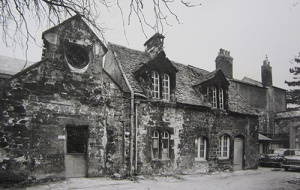
Works Department in the 1960s
At that stage there the Works Department occupied an old cottage on this site with some stables.
Any discussion of a replacement building, therefore, had to take account of the existing needs of the Works Department.
The first, very ambitious, plan was to create a building to accommodate student accommodation, new offices and workshops for the Works Department, and a mess room and lavatories for the kitchen staff. After a short while, though, the College settled on the more reasonable project of combining the facilities for the Works Department and Kitchen with a room for the Middle, or Weir, Common Room.
By 1967 John Fryman of the Architects Design Partnership had been chosen as the architect for the project (he would later oversee the refurbishment of 83-85 High Street and the creation of Cecily’s Court). This project was being conceived at exactly the same time as Stavertonia, and papers of the time show that both projects were discussed in tandem.
This building, then, and its functions had been in the planning for a little while before a benefactor was found for it, and it is time to introduce that benefactor.
Sir Harold Mitchell (1900-83) had come up to Univ in 1919 to read History. He was one of the few freshers of that year who had been too young to serve in the First World War. In his memoir, The Spice of Life, Mitchell remembered that he found it difficult to relate to the former soldiers who were up at the same time, and he admitted to finding post-war Oxford “chaotic”. Nevertheless, he generally enjoyed his time here.
On going down from Univ, Mitchell entered business, first running a glassworks which was almost defunct until he took it over. He was also a politician, serving as Conservative MP for Brentford and Chiswick from 1931-45. He held junior ministerial posts in various departments, and from 1942-3 was Vice-Chairman of the Conservative Party. He was created a baronet in 1945.
On losing his seat in the 1945 election, Mitchell devoted himself exclusively to his business interests, purchasing mines in Canada, and farms in the West Indies. He became an authority on Caribbean matters, writing several books on the subject, and for a time was a Research Professor specialising in Latin-American studies at Rollins College, Florida.
Above all, however, Mitchell was an active philanthropist, especially with regard to educational causes: he was a founder of Prospect College, Jamaica, helped raise funds for the University of the West Indies, and endowed two scholarships at St Andrews University for overseas students. He spent much of his later life in Bermuda, where he died in 1983.
A file among the papers of John Maud, Lord Redcliffe-Maud, our Master from 1963-76 (ref. UC:MA49/1/C1/3), show how the building project and the benefactor came together. Sir Harold Mitchell was invited to the St. Cuthbert’s Feast in March 1968. He clearly had a good time, because on 25 March, he wrote to Maud expressing his pleasure at the evening. This was no ordinary thank-you letter, however: Mitchell continued:
“I was greatly interested in what you told me on Saturday about the vigorous College building programme. It is particularly encouraging to see so much being undertaken for graduate education.
“As I mentioned to you, I will be very pleased to contribute to this programme by taking on the cost of the Graduate Common Room Building which I understand will be of the order of £35,000 to £40,000.”
Mitchell’s letter is reproduced here:
Every head of an Oxford college would rejoice to receive such a letter.
There are hints that both Shock and Maud may have been planning to solicit a benefaction from Mitchell before the Feast, because it appears that, on that day, the two of them had a private meeting with our then Estates Bursar, Maurice Shock. No doubt Mitchell himself came to Oxford aware that some call upon his generosity might be made. The fact too that it was the College which suggested that Mitchell might support an existing proposal suggests that at this meeting Mitchell was informed about all the College’s building projects, and chose to support this particular one, because of its importance to graduate students. Nevertheless, few College Feasts can have had quite so happy an outcome.
Master and Bursar met Mitchell again in July 1968 to discuss the scheme in more detail, and by September the design of the new building had been fairly well fixed. Fryman even met a delegation from the MCR in November 1968, who had various issues to raise about the MCR space, including a quiet space where graduates could work, the creation of a pantry, the installation of a telephone, and lavatories. On the last point, the minutes of the meeting report that “It was suggested that what the architect described as “separate bean shaped pissoirs with separate flushing” would be heaven.” Univ in 1968 was still all-male, of course.
By Christmas 1968, the Master could even write to Mitchell that he hoped that that his building would be ready for use by October 1970, and by May 1969 the Works Department had vacated the old cottage, which was now demolished.
Whereas both the financing and the obtaining of planning permission for Stavertonia proved a most tortuous business, progress on the Mitchell Building proved far smoother. Not only did the project rely on just a single benefactor, but there also seems to have been far less trouble about planning permission. The main issue seems to have been that Merton College opposed a proposal to include three windows on the south side of the building, overlooking Grove House. In the end the College had to agree to scrap those windows.
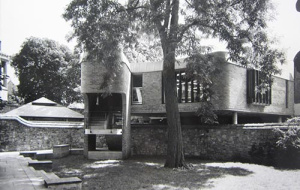
The Mitchell Building around the time of its official opening
To be sure, the completion date of October 1970 proved a little optimistic: in July that year, after a rather awkward meeting with the architects and the contractors, Maud had to write to Mitchell to suggest that an opening ceremony in January or February might be more prudent. Such a date did not fit with Mitchell’s other commitments, and so, although the building was in use from early in 1971, the actual opening ceremony finally took place on 9 June 1971.
The opening ceremony went without a hitch, and on the following day Mitchell wrote to Maud to express his pleasure both at the company and the new building:
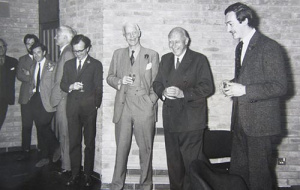
Opening ceremony of the Mitchell Building. R to L: Frank Booth (then MCR President), Sir Harold Mitchell, Lord Redcliffe-Maud, and Maurice Shock
“I was immensely pleased to have the chance of meeting the graduate students. They are a delightful and impressive group. What interested me was their diversity of origin and fields of study.
“The Mitchell Building not only looks extremely well but seems to serve its purpose most effectively. I was always a little fearful that it might not harmonise with the beauty of the College, but the skill of you all has resulted in a most successful symmetry. The colour of the bricks struck me as particularly effective.”
The College showed its gratitude to Sir Harold by electing him an Honorary Fellow in 1972.
Towards the end of his life, Mitchell also made a significant contribution towards the renovation of 90 High Street, and then in the mid-1990s the Mitchell family made another benefaction to the College. This more recent gift is commemorated by the creation of Mitchell Court at 90 High Street, where a plaque records the names of Sir Harold himself, his wife Mary, and his daughter Mary-Jean (St. Anne’s 1971). This plaque was unveiled in May 1995 by Mary-Jean’s widower Peter Green.
By the time of the opening of the Mitchell Building, the Middle, or Weir, Common Room had been in existence for just over a decade. As a postscript to this account of the Mitchell Building, we therefore give below a memoir of the creation of the MCR in 1960 which the first MCR President, Ian Graham-Bryce (1954, Agriculture and Forest Science), wrote for the 2010 issue of the University College Record.
A memoir of the creation of the MCR
Published: 4 November 2021

